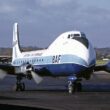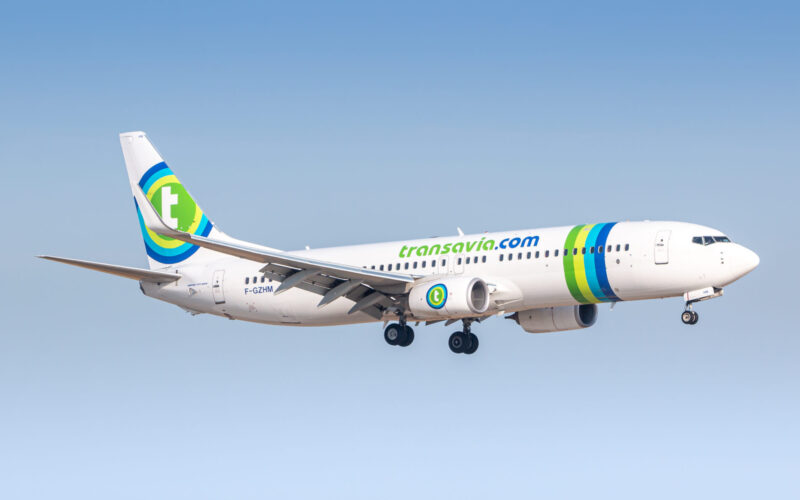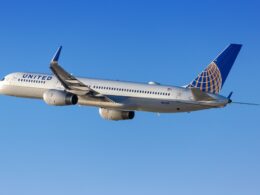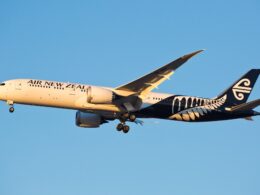A dysfunctional Angle of attack (AoA) sensor and failure to properly follow maintenance procedures led to a Transavia Boeing 737-800 conducting a turn around in Paris, France, a newly published incident final report revealed.
The problems for the Boeing 737 started when a Transavia flight crew had to ferry another aircraft to maintenance in Norwich, United Kingdom from Paris, France. For the return leg to Paris, the flight crew hopped on the 737 in question, registered as F-GZHO, which left maintenance and was supposed to enter service the next day, according to a report released by the Bureau of Enquiry and Analysis for Civil Aviation Safety (BEA) on November 16, 2020.
The Boeing 737-800, which was delivered off the shelf to the Air France-KLM low-cost subsidiary Transavia in February 2015, concluded its C-Check on February 7, 2018, and was due to enter commercial service on the next day.
Ferry flight issues
As the aircraft departed from Norwich Airport (NWI) towards Paris Orly Airport (ORY), both pilots’ Primary Flight Displays (PFD) showcased the Indicated Airspeed (IAS) DISAGREE alert upon the rotation of the aircraft. Prior to it touching off the ground, neither of the two flight crew, in addition to a representative of the airline’s maintenance operations, noticed anything out of the ordinary.
When the captain pulled back the yoke of the 737 and began to lift the nose of the aircraft, the IAS DISAGREE alert appeared on both PFDs, with AoA DISAGREE AND ALT DISAGREE appearing a bit later during the initial climb. Both of the pilots acknowledged the appearance of the alerts and, after cross-checking their displays, noticed that the right-hand side PFD was showcasing erroneous speed indications while the left-hand one showcased data identical to the standby airspeed indicator.
Despite the erroneous data and the alert regarding the aircraft’s airspeed, the crew decided to continue the flight and to not open up the flight manual and carry out the indicated checklist in order to amend the faulty data and the alert. The captain argued that he took this decision due to the fact that his PFD was showcasing correct data and because the amount of air traffic within the London Terminal Control Area (TMA) was very high.
While the difference between the altitude and airspeed showcased on both PFDs continued to increase as the Boeing 737 continued to climb to FL200, which was its designated cruise altitude. At the cruise altitude, the flight crew carried out the AoA DISAGREE, ALT DISAGREE and IAS DISAGREE checklists, which led them to the Airspeed Unreliable procedure.
“Both pilots consulted this procedure but did not apply it as they had identified the erroneous indication and knew that the left PFD indication was correct,” concluded the French investigators.
The flight continued on to ORY without any issues or emergency calls to Air Traffic Control (ATC). During the descent, the captain contacted Transavia’s maintenance department in order to report the issue and requested the problem to be fixed. In addition, the problematic flight was logged in the Aircraft Flight Log (AFL).
Spotty maintenance and overweight turn around
Following the flight, a maintenance technician inspected the aircraft but found no issues. However, a turn around on the next day proved that the issue was yet-to-be solved.
The Transavia Boeing 737-800 was scheduled to depart Paris Orly Airport (ORY) towards Marrakesh, Morocco, in the early morning hours of February 8, 2018 ‒ a day following the ferry flight from NWI. During the flight to the North African country, the pilot flying (PF) was a trainee captain, while the pilot monitoring (PM) was a captain that assumed the position of a first officer in order to train the to-be captain.
During the take-off run, the trainee pilot had noticed that his PFD showcased a speed of 80 knots, at which point the flight manual required a cross-check of speed. Once again, the PFDs showcase irregularities in their speed indications, and shortly after reaching a speed of 90 kts, the IAS DISAGREE once again appeared on the flight display. Following the alert, the instructor took over the duties of PF and terminated the training procedures in order to deal with the situation.
Much like during the prior day’s flight, the AoA DISAGREE and ALT DISAGREE joined the party, in addition to the irregularities in PFD data across the two cockpit seats. Once again, the flight crew referred to the Airspeed Unreliable procedure and stabilized the aircraft at FL90. Subsequently, the training instructor declared PAN PAN and landed at Orly Airport (ORY) 40 minutes after the Boeing 737 departed. No injuries were sustained onboard.
The final incident report by BEA revealed that the maintenance technician, who was assigned to work on the aircraft following the ferry flight the day prior, failed to follow procedures in the Fault Isolation Manual (FIM). While the technician relied on the Aircraft Maintenance Manual (AMM) procedures to inspect the AoA sensors, pitot probes and static pressure ports, he did not notice anything abnormal, read the report.
“He explained that he did not consult the procedures in the Fault Isolation Manual (FIM) corresponding to each alert but that the actions that he carried out ultimately corresponded to what was required by the FIM,” commented the French investigators.
Following the turn around at Paris, a Stall Management Yaw Damper Computer (SMYC) test showcased issues with the right-hand AoA sensor, requiring its replacement. After a fresh AoA sensor was installed, the aircraft once again returned to commercial service without any issues on February 9, 2018.
Faulty manufacturing practices?
The incident not only revealed potential shortfalls in maintenance but manufacturing practices as well.
Following the incident, Transavia handed over all flight data recorded by the Boeing 737’s maintenance recorder (QAR) since March 2015 to BEA, shortly after Boeing first delivered the aircraft to the low-cost carrier. A deep dive into the data showcased that the troublemaker right-hand AoA sensor had gradually degraded over time, while the left-hand side sensor showcased no issues.
“The start of this dysfunction can be detected in the QAR data as early as March 2015, just a few weeks after the airplane had been delivered to Transavia. The dysfunction then becomes significantly more marked and is visible up to the last flight before the maintenance work in Norwich,” read the report.
However, the QAR cannot showcase the appearance of an AoA Disagree alert. Instead, the alert is generated by an electric resolver, namely resolver 2 that sends data to the Air Data Inertial Reference Unit (ADIRU). In an AoA sensor on a Boeing 737, there are two resolvers: resolver 1 sends data to the SMYC, while resolver 2 sends data to the ADIRU.
The faulty sensor was examined by KLM Engineering and Maintenance and BEA. After the examination, which determined that the sensor’s internal components were damaged, resolver 2 was sent to Collins Aerospace. North Carolina, United States-based company produces many products across the aerospace industry and is a Boeing supplier.
Collins Aerospace looked at the resolver with MOOG, a supplier of the former. The two suppliers found that a substance obstructed the movement of the rotor and the stator on the resolver. The substance at question was Tetra Hydro Furfuryl Alcohol (THFA), used in the manufacturing process.
After the US manufacturer performed tests, it updated its material handling procedures to prevent THFA contaminating with either of the two resolvers.
“Collins Aerospace considered that the damage to the gears and the deformation by torsion of the resolver 2 shaft was probably the result of abnormal loads experienced since 2015 due to the blocking caused by the contamination,” concluded BEA.
Shortfalls in the cockpit
The way that both crews had dealt with the two alerts also came to the attention of the investigators.
First off all, BEA’s report read that the Unreliable Speed procedure requires pilots to complete the first four memory items that “must be complied with immediately, as soon as the abnormal situation is identified.”
“In the two incidents, the pilots did not immediately carry out the memory items. In both cases, they first tried to identify the side which was supplying the erroneous information and initially used this assessment to continue the flight with the automatic systems engaged,” further read the report.
French investigators were further puzzled why the pilots did not reject the take-off, despite not being at V1 speed, at which a decision whether to continue the take-off or reject it is due to take place. The confusion was further fueled by the importance of airspeed to a flight, as irregularities in airspeed data should result in a rejected take-off if it is still possible to do so.
Crews of the two flights told BEA that they had not considered the situation to be dangerous. However, in hindsight, both captains would have been “willing” and found it “preferable” to reject the take-off. Favorable weather conditions could have also contributed to the fact that both crews did not abandon the take-off procedures during their respective flights.
The investigators were also very critical of the fact that the crews had not gone through the Airspeed unreliable checklist to prevent automatic systems from relying on erroneous data and, subsequently, engaging with the aircraft’s control. According to the BEA, such action must be done prior to any analysis of the situation.
“Finally, transmitting a PAN PAN message in order to notify a technical issue allows the ATC to take precautionary measures if necessary. It can often help reduce the crew’s workload,” concluded BEA.
UPDATE 17-11-2020, 10:58 AM (UTC +3): the story first incorrectly identified a turn around as a go-around.











